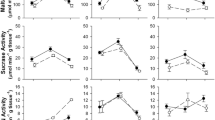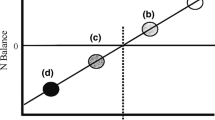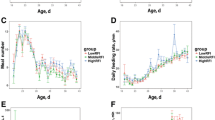Summary
Raising captive species of birds on commercial, concentrated feeds prior to release in wild environments may preclude the success of such reintroductions. Interactions must occur between the components of a diet, foraging behaviours and the morphological development of the alimentary tract of young birds. It is vital to precondition the digestive system to the types of wild foods each bird will encounter in its wild habitat in order for reintroduction programmes to succeed. Commercial type rations, while producing rapid and efficient body growth, may not condition the digestive system to the bulky, more fibrous, and less digestible foods birds will encounter after release. They certainly do not encourage optimal foraging behaviours and reinforce specific appetitive behaviours. Herbivorous species which consume appreciable amounts of secondary compounds with their food should be given these compounds so that the enzyme system involved with metabolizing them can be activated before release to the wild.
Zusammenfassung
Die Fütterung von Vögeln mit handelsüblichem Futter vor ihrer Freilassung in die Natur ist nicht zu befürworten. Handelsübliche Futtermischungen wurden entwickelt, um maximales Wachstum mit besonderer Betonung des Muskelwachstums zu erzielen. Sie sind im allgemeinen sehr gut verdaulich und enthalten hohe Nährstoffkonzentrationen; daher entwickelt sich der Darm nur unzureichend. Vögel, die nur handelsübliche Futtermischungen erhalten, werden außerdem kaum in der Lage sein, natürliche Nahrungsquellen zu erkennen. Die Nahrung freilebender Pflanzenfresser ist für gewöhnlich weniger gut verdaulich und hat einen geringen Nährstoffgehalt. So ist in den meisten Fällen ein vielseitiges Nahrungsangebot für das Überleben entscheidend. Um die Ernährung zu sichern, müssen viel mehr Ballaststoffe aufgenommen werden als in kommerziellen Futtermischungen enthalten sind. Die Anatomie des Verdauungstraktes ist an die natürliche Nahrungswahl angepaßt und verändert sich als plastisches System mit der Eigenschaft der aufgenommenen Nahrung. Bei der Aufzucht zur Freilassung ist die Beachtung der Wechselwirkung zwischen Eigenschaften der Nahrung, der Entwicklung des Verdauungssystems und den Komponenten des Verhaltens beim Nahrungserswerb von größter Wichtigkeit. Jungvögel müssen daher auch mit Futterrationen geringen Nährstoffgehaltes gefüttert werden, um in Freiheit reelle Überlebenschancen zu haben. Vögel, die mit Wildfutter aufgezogen werden, lernen dadurch auch, Nahrungsquellen nach ihrem Nährwert zu unterscheiden. Dieser Aspekt im Verhalten ist für das Überleben in Freiheit ebenso wichtig wie ein ausreichend entwickelter Darm. Freilebende Pflanzenfresser sind einem großen Spektrum von Mykotoxinen ausgesetzt, die vom Körper metabolisiert werden müssen. Enzymketten müssen dafür aktiviert werden. Die Fütterung von Naturfutter vor der Freilassung schafft daher auch die nötigen Bedingungen für den Stoffwechsel, mit diesen zusätzlichen Belastungen fertig zu werden. Man sollte also magere, die effizient ihre Nahrung suchen können, nicht groß oder fette Individuen aufziehen. Handelsübliche Futtermischungen einzusetzen, ist zwar ökonomisch wesentlich günstiger; will man jedoch freilebende Populationen aufbauen, dürfen Kosten und Arbeitsaufwand nicht die allein entscheidenden Faktoren sein. Die Entscheidung, ob entsprechende Maßnahmen ökonomisch und ökologisch sinnvoll waren, wird allein von der Lebenserwartung der ausgesetzten Vögel in Freiheit bestimmt, nicht durch die Zahl von freigelassenen Individuen mit scheinbar guter Kondition.
Similar content being viewed by others
Literature
Banks, R. C. (1981): Summary of foreign game bird liberations, 1969–1978. U. S. Dept. Interior, Fish and Wildl. Serv. spec. Sci. Rpt. Wildl. No. 239. Washington, D. C.
Barnes, G. G., &V. G. Thomas (1987): Digestive organ morphology, diet, and guild structure of North American Anatidae. Can. J. Zool. 65: 1812–1817.
Fenna, L., &D. A. Boag (1974): Adaptive significance of the caeca in Japanese quail and spruce grouse (Galliformes). Can. J. Zool. 52: 1577–1584.
Haensly, T. F., S. M. Meyers, J. A. Crawford &W. J. Castillo (1985): Treatments affecting post-release survival and productivity of penreared ring-necked pheasants. Wildl. Soc. Bull. 13: 521–528.
Irving, L., G. C. West &L. J. Peyton (1967): Winter feeding program of Alaska willow ptarmigan shown by crop contents. Condor 69: 69–77.
Kehoe, F. P., &C. D. Ankney (1985): Variation in digestive organ size among five species of diving ducks (Aythya spp.). Can. J. Zool. 63: 2339–2342.
Kleiber, M. (1975): The fire of life: an introduction to animal energetics. Huntington, New York.
Korschgen, L. J. (1964): Foods and nutrition of Missouri and midwestern pheasants. Trans. North Am. Wildl. Conf. 29: 159–180.
Lewin, V. (1963): Reproduction and development of young in a population of California quail. Condor 66: 249–278.
Mainguy, S. K., &V. G. Thomas (1985): Comparisons of body reserve buildup and use in several groups of Canada geese. Can. J. Zool. 63: 1765–1772.
Miller, M. R. (1975): Gut morphology of mallards in relation to diet quality. J. Wildl. Managem. 39: 168–173.
Moss, R. (1972): Effects of captivity on gut lengths in red grouse. J. Wildl. Managem. 36: 99–104.
Ditto (1974): Winter diets, gut lengths, and interspecific competition in Alaskan ptarmigan. Auk 91: 737–746.
Ditto &I. Hanssen (1980): Grouse nutrition. Nutrition Abstracts and Reviews — Series B. 50: 555–567.
Palo, R. T. (1984): Distribution of birch (Betula spp.), willow (Salix spp.), and poplar (Populus spp.) secondary metabolites and their potential role as chemical defense against herbivores. J. Chem. Ecol. 10: 499–520.
Pendergast, B. A., &D. A. Boag (1973): Seasonal changes in the internal anatomy of spruce grouse in Alberta. Auk 90: 307–317.
Savory, C. J., &M. J. Gentle (1976a): Effects of dietary dilution with fibre on the food intake and gut dimensions of Japanese quail. Br. Poult. Sci. 17: 561–570.
Ditto (1976b): Changes in food intake and gut size in Japanese quail in response to manipulation of dietary fibre content. Br. Poult. Sci. 17: 571–580.
Scott, M. L., E. R. Holm &R. E. Reynolds (1963): Studies on the protein and methionine requirements of young Bobwhite Quail and young Ring-necked Pheasants. Poult. Sci. 42: 676–680.
Summers, J. D., W. F. Pepper &E. T. Moran (1972): Poultry feed formulas. Ontario Ministry Agriculture and Food.
Thomas, V. G. (1983): Spring migration: the prelude to goose reproduction and a review of its implications. In:H. Boyd (ed.): First Western Hemisphere Waterfowl and Wetlands Symposium. Can. Wildl. Serv. Spec. Publ. Ser. 73–81.
Ditto (1984): Winter diet and intestinal proportions of rock and willow ptarmigan and sharp-tailed grouse in Ontario. Can. J. Zool. 62: 2258–2263.
Woodard, A. E., P. Vobra, &R. L. Snyder (1977): Effect of protein levels in the diet on the growth of pheasants. Poult. Sci. 56: 1492–1500.
Author information
Authors and Affiliations
Rights and permissions
About this article
Cite this article
Thomas, V.G. Nutritional, morphological, and behavioural considerations for rearing birds for release. J Ornithol 128, 423–430 (1987). https://doi.org/10.1007/BF01644658
Published:
Issue Date:
DOI: https://doi.org/10.1007/BF01644658




